Site Menu:
| This is an archived Horseadvice.com Discussion. The parent article and menus are available on the navigation menu below: |
| HorseAdvice.com » Diseases of Horses » Lameness » Lameness topics not covered above » |
| Discussion on WLD and resulting collateral ligament strain | |
| Author | Message |
| Member: frances |
Posted on Thursday, Jul 16, 2009 - 6:17 am: I'm not sure whether I should post this in the hoof problems section, or the ligament problems section? Please move it DrO if it is not in the right place.My horse felt NQR for a while and eventually showed up lame in the RF on June 18. Vet came and found a soft lump with something hard deeper in on the lateral pastern. Said it could be a trauma, but the inner hardness might be a small bone spur, and that it was right over a ligament. He recommended topical treatment of 150gr Hemeran gel (Heparinoid 1%) mixed with 15ml DMSO. If there was no improvement when he came back in a week, he'd ultrasound it. He also commented that the mare needed shoeing, so the next day I had the farrier out, and he discovered a pretty bad case of WLD in the same foot. This is at 5 weeks in her usual 6-weekly trimming cycle, and it seems hard to believe that it could have spread so far in that time. This farrier leaves my mare's front shoes really worn at the toe, saying that it is actually better for her in view of her arthritis (Hmm, I rather suspect this is the lazy man's way of rolling the toes) and I can't help thinking this may have made it easier for microbes to gain entry. I'll try to post pictures of the hoof and the lump later today. The farrier cut away all he could, but said he couldn't cut any closer to the coronet and we'd have to wait for it to grow down. Meanwhile, to clean out the hollow part twice a day with a shoeing nail and then spray all the exposed part, and up into the hollow part. (I hold the hoof upside down and spray down into the hollow, hold the hoof like that for a minute so gravity can allow the medication to trickle in. Afterwards I tamp in a narrow strip of cotton soaked in iodine to keep shavings/manure etc from getting up into the hollow. The vet came on June 24 to take x-rays, and as soon as he saw how much hoof had had to be cut away he commented that the hoof's instability was the cause of the pastern lump. When he'd read the x-rays, he told me there was a large hole in the hoof, that more wall needed to be removed, and that the mare pretty much has half a hoof. The lateral pastern lump, he said, was due to collateral ligament strain caused by the hoof's instability. The strain was not too severe, but would take 2 or 3 months to heal, he thought and, combined with the fact that she has basically only half a hoof, means that she can't do anything other than handwalking. I found that handwalking made her sore however, so I am simply giving her a holiday, which means in all day and out in small paddock 11 hours at night. The vet also said that there was no rotation shown on the x-ray, but signs of a small bone spur. The farrier said on June 19th that he had just tacked the RF shoe on lightly as he was thinking of putting a heartbar shoe (I THINK he said heartbar)on with a pad or a half pad for frog support. He was waiting for something firmer than silicone to be used under the pad, and would get it probably the next week. However, I've heard no more about it and haven't been able to get hold of him. Question 1: does the appliciation of a heartbar and pad seem like a good idea? Question 2: the other front leg, the left, has been a disaster zone over the years with suspensory desmitis, arthritic knee, and a split open knee last year. I am concerned about any adverse effect to this knee, i.e. I don't want it to have to bear additional weight/strain. Should both feet be shod the same way, or is this not necessary? Question 3: is the farrier right in saying he's cut as much hoof wall as possible for now? 3 1/2 weeks have passed, and I'm worried that there might be some missed areas of infection in the hollow part that could reach the coronet. Should it not be pared out more often? So sorry for such a long post, and I hope to have pics to clarify things. Many thanks |
| Moderator: DrO |
Posted on Thursday, Jul 16, 2009 - 7:51 am: Taking your questions in order LL:1) I myself am not much of a fan for heartbars as I do not think frogs are designed for constant pressure. 2) You can shoe feet differently without adding stress to the other leg as long as proper length and balance are used. 3) How much and how often is a judgement call based on the case in front of you however there are not any ill consequence paring out diseased WL because it is not supporting anything anyway: if you are treating "holes" it suggest to me more needs doing. DrO |
| Member: frances |
Posted on Monday, Jul 20, 2009 - 3:48 am: Hi DrO, Thanks a lot for your reply. I'm glad to say the farrier has changed his mind about the need for heartbars.Here (hopefully) are the pictures for the record. The date setting on the camera is wrong, and should be June 21st 2009. 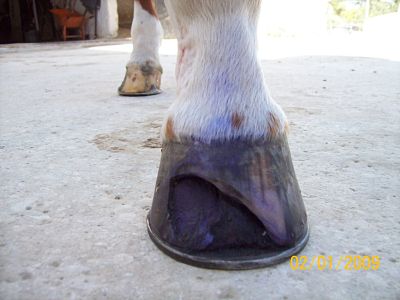
|
| Member: frances |
Posted on Monday, Jul 20, 2009 - 4:23 am: ...the "Upload Attachment" button seems to have gone on strike ??
|
| Moderator: DrO |
Posted on Monday, Jul 20, 2009 - 8:25 am: The image displayed what type problem are you having LL?DrO |
| Member: vickiann |
Posted on Monday, Jul 20, 2009 - 12:20 pm: Dr. O, This morning I just read your article on this subject and it is great! Thanks for such a terrific resource. |
| Member: vickiann |
Posted on Monday, Jul 20, 2009 - 4:48 pm: I goofed and posted in the wrong place. Those articles are good too, of course, but the ones that I just read today were the ones in the prior link about stifle lock. This is a subject that I knew little about and I found the articles very interesting and comprehensive. |
| Member: frances |
Posted on Tuesday, Jul 21, 2009 - 11:50 am: Thanks DrO, I wanted to post this image as well, but couldn't seem to. I'm sure it was my mistake.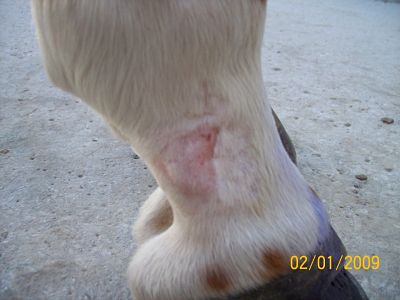
|
| Member: frances |
Posted on Tuesday, Jul 21, 2009 - 12:08 pm: For some reason the description didn't appear; this is the swelling over the collateral ligament due to the destabilised hoof.And here's a larger image of the WLD hoof: 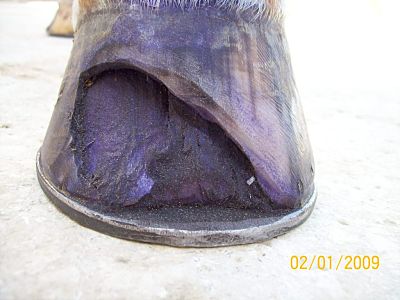
|
| Moderator: DrO |
Posted on Wednesday, Jul 22, 2009 - 9:11 am: Hmmmmm, the swelling is either do to where the WLD broke through to sensitive tissue or the extra pressure concentrated at the quarters from the destabilized hoof LL. I think it warrants addressing. Is there any current lameness?A few recommendations: First that you limit exercise to smaller areas with very soft bedding to help move weight bearing off the wall. Second consider moving more support to the sole with some of the modern urethane sole packing material. You are likely to do more good with fewer complications with this technique versus a heartbar. Lastly I would consider the use of NSAID's for reducing the swelling. DrO |
| Member: frances |
Posted on Thursday, Jul 23, 2009 - 9:24 am: No forced exercise, only that which she chooses in small bare paddock all night. No bedding there, but I would have to stall her 24/7 for her to have soft deep footing. Hmmm...No current lameness. At present she has only topical NSAIDS: diclofenac diethylammonium gel applied twice daily (instead of the heparinoid/DMSO mixture described in my first post - vet said I could use either). She did have bute when it seemed handwalking was making her sore; I stopped the handwalking and gave her 1 gm that day and another the next for good measure, although by then she already seemed comfortable. The farrier should come tomorrow to shoe some of the other horses and I'll suggest the urethane sole packing material to him. (He's quite touchy about anyone seemingly trying to tell him how to do his job  .) .) As the above image is from June 21st, I took another pic this morning to see if you felt there was improvement, but I left my camera at the stables, so will post it tomorrow. |
| Member: frances |
Posted on Friday, Jul 24, 2009 - 8:39 am: So here is a photo of the swelling taken yesterday, about one month after the previous one.Do you see any improvement DrO? 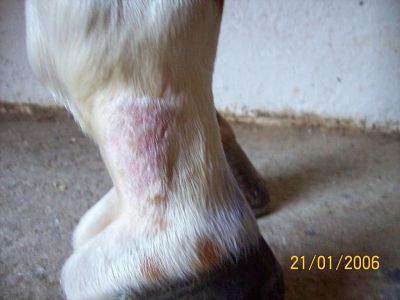
|
| Moderator: DrO |
Posted on Saturday, Jul 25, 2009 - 6:56 am: LL I do not see the swelling well from either image. What do you think as you can examine it from all angles and in all lighting.DrO |
| Member: frances |
Posted on Tuesday, Jul 28, 2009 - 7:59 am: Hi DrO.I agree that the images are not too clear and as I see the swelling every day it's hard to assess progress. So I had the vet come out (he was due to check on my mare around now anyway). He had me trot her up and was pleased with her trot (straight line). He palpated the lump and found it to be in a "calm" state, and thought it would therefore be a good time to ultrasound. The ultrasound showed little remaining inflammation to the collateral ligament, just a small amount to the rear of it. He showed me the lesion on screen, and said that it was filling in nicely with well-aligned fibres. There is a small bone spur, but it is not affecting the collateral ligament (it's close to the SDFT, but not affecting that either, for now at least.) He suggested that I start to apply topical heat such as Counterpain, now instead of the topical anti-inflammatories I've used up to now. He was surprised that the hoof wall had not grown down more, as it's getting on for 6 weeks now. I'm giving her Farriers Formula, but growth is still slow. Just have to be patient. Didn't think of mentioning it to him, but would "Cornucrescence" (sp?) be helpful here? He said to start handwalking again, as long as it doesn't make her sore. He doesn't feel she need pads. No work of course until the hoof has grown further. Any comments would be welcome. |
| Member: frances |
Posted on Tuesday, Jul 28, 2009 - 8:23 am: I've just looked up the product that is supposed to promote hoof growth: correct spelling is Cornucrescine original hoof ointment (Carr Day & Martin).However, they only give "essential oils and lanolin" as ingredients, so I feel disinclined to try it, unless any other members have found it good? It's a UK product I believe. |
| Moderator: DrO |
Posted on Tuesday, Jul 28, 2009 - 8:27 am: LL what is "Cornucrescence"? So the swelling is a fluid build up around the ligament?DrO |
| Member: frances |
Posted on Tuesday, Jul 28, 2009 - 11:29 am: DrO,He didn't specifically say it was fluid, but I suppose that's what it would be....? I should have asked him. My last post explaining what Cornucrescine is must have crossed with your reply. It's a traditional product that's been around for decades, but now that I see they don't list their ingredients my HA-training has kicked in! |
| Member: frances |
Posted on Wednesday, Jul 29, 2009 - 6:26 am: ..forgot to mention that it is rubbed into the coronet... |
| Moderator: DrO |
Posted on Wednesday, Jul 29, 2009 - 8:18 am: Hello LL,We discuss good and bad topical hoof preparation ingredients at Diseases of Horses » Lameness » Diseases of the Hoof » Wall Cracks and Thin Sensitive Soles. DrO |
| Member: frances |
Posted on Sunday, Oct 25, 2009 - 11:07 am: Here's an updated photo of the hoof three months on. You can't see it of course but she now has a pad with dental impression material underneath for support.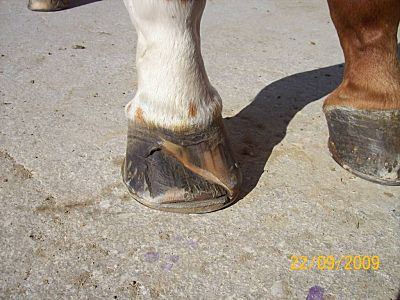
|
| Member: frances |
Posted on Sunday, Oct 25, 2009 - 11:32 am: And this one is four months from the resection, three days ago: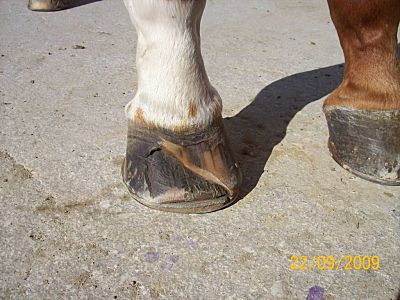
|
| Member: frances |
Posted on Sunday, Oct 25, 2009 - 11:38 am: Side view from three days ago. No sign of swelling over ligament.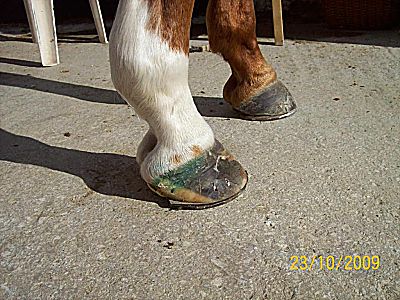
|
| Member: frances |
Posted on Sunday, Oct 25, 2009 - 12:45 pm: It doesn't look to me as if there's been as much regrowth as I would have expected in four months. Granted, the highest point of the resection, closest to the coronet, has been cut away a little more each shoeing cycle (this was not because of new infection, but because both farrier and vet thought it unwise to cut too close to the coronet).I am really confused as to what I should be applying to the resected area. For the first month I was spraying it twice daily with a product called Ritchey's Footcare and Cleansing Spray (I don't have a can in front of me, but I think it contains benzalkonium chloride and methyl violet as a marker), then reducing it to once daily for two months. I would allow it to dry, and then cover it with hoof grease as a barrier and to prevent the hoof from drying out and becoming too hard. After that I changed to iodine tincture, again applied once daily and coated with hoof grease when dry, but I became somewhat concerned (or horrified, to be honest) last week when I read in The Horse magazine online that iodine tincture should not be used as it could damage the hoof irreversibly. DrO, what I would like to ask is: 1) have I been over zealous in treating the hoof and could this, especially the use of iodine tincture, have contributed to the slow regrowth from the coronet? 2) although I've read in many articles that if the hoof is kept clean and dry the debridement alone is all that's necessary, but in our warm, humid and at present very rainy climate there's no way IMO that nasty critters can be kept out, so I feel I must use some product or other. In your article you recommend formaldehyde but it is not easily available here. What would you consider best out of the following products: copper sulphate betadine the benzalkonium chloride spray I mentioned pine tar? Many thanks. |
| Member: frances |
Posted on Sunday, Oct 25, 2009 - 1:08 pm: Uh oh, I think I'm getting sleepy. I see I posted the same pic twice by mistake - so, the second front view image also shows the hoof at three months, not four.Sigh ... let me try again and try to upload the 23/10 one. So sorry ... 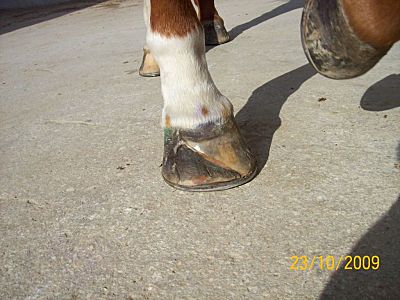
|
| Moderator: DrO |
Posted on Monday, Oct 26, 2009 - 7:46 am: LL,This statement says it all: It doesn't look to me as if there's been as much regrowth as I would have expected in four months. Granted, the highest point of the resection, closest to the coronet, has been cut away a little more each shoeing cycle (this was not because of new infection, but because both farrier and vet thought it unwise to cut too close to the coronet).How can the wall grow out if it is cut back because it is undermined with infection each time. And after several shoeing cycles I would have thought they would realize the infection grows faster than the hoof wall does. Sometimes much faster. You have to cut it all out. Everyone that has trouble treating WLD on these boards has some good reason for not cutting it all out. I understand about the concern of destabilizing the hoof wall if it is completely transected from coronet to ground but the shoe and using stabilization with artificial hoof appliance or a wide metal patch can be used further down where the infection is under control. Until completely cut out I don't think it will matter much what you use and once cut out it would not surprise me if any of the antimicrobials you list might be effective (no pinetar). I would suggest you use the treatments recommended in the article however. DrO |
| Member: frances |
Posted on Tuesday, Oct 27, 2009 - 2:17 pm: Thank you DrO.In the statement I wrote "this was NOT because of new infection" but I guess you're saying that I'm wrong in thinking this. I did ask the farrier right from the start to cut all of it away, but he refused to. Still, the area he left was very shallow, never showed any sign of crumbly stuff and was scrubbed out and aggressively treated every day. At each shoeing cycle farrier came closer to removing everything, (he finally has) and I thought that we had escaped any further infection. This is why I was asking if tissue toxic topicals could be delaying the regrowth. |
| Moderator: DrO |
Posted on Wednesday, Oct 28, 2009 - 7:53 am: Applying iodine tincture to the horn, a time honored method of toughening soles, is not going to slow wall growth LL. It does have a dehydrating effect which may make the horn harder with time. Now that you have it all cut away you should not have trouble eliminating the infection and once you quit having to cut it back I think you will find it grows out normally.DrO |
| Member: frances |
Posted on Thursday, Oct 29, 2009 - 7:47 am: Thanks for the advice, and I hope one day in the future I'll be able to post images of a normal healthy hoof
|
| Moderator: DrO |
Posted on Thursday, Oct 29, 2009 - 9:34 am: With proper treatment and care the prognosis is excellent.DrO |
| Member: frances |
Posted on Friday, Dec 25, 2009 - 9:32 pm: Hi Dr0, I'm curious as to what exactly the fissure at the front bottom of the resected area is. It's been growing down all along of course, and I see it in a lot of WLD pictures so I know it's not unusual ... but what IS it?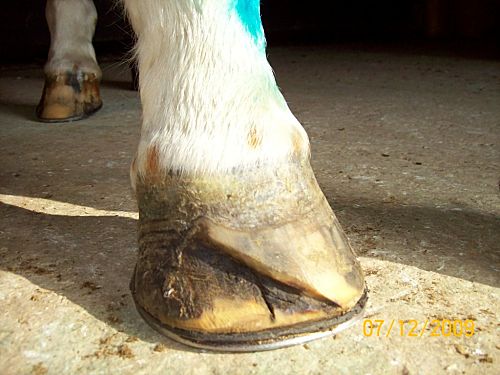 I emailed the vet this photo and asked him if he thought we could start a small amount of slow trot, but he didn't recommend it until the crack had completely grown out. I forgot to mention to him that she does wear a pad with dental impression material under it - possibly that would have made a difference? |
| Moderator: DrO |
Posted on Sunday, Dec 27, 2009 - 9:09 am: The insensitive laminae has split here LL. It is not strong enough to bear weight. I would consider unloading this spot at the shoe before it penetrates to sensitive tissue and becomes painful. This would consist of rasping the area distal shorter so that it does not rest on the shoe. Be sure the crack stays clean and dry so that infection does not start up in it.No I would not ride on this foot either as it may cause the crack to propagate faster. DrO |
| Member: frances |
Posted on Sunday, Dec 27, 2009 - 12:01 pm: Thank you very much DrO |
| Member: frances |
Posted on Tuesday, Dec 29, 2009 - 8:32 am: Sorry, one more question DrO so that I can explain it to the farrier:Re rasping the area distal shorter, am I right in understanding that he should rasp out a small hollow, maybe like a crescent, just below the crack? (He is inclined in cases of seedy toe to cut a triangle out of the wall; that would not be the shape you mean, I think? I remember something about abducting forces...) I really appreciate your help in this. |
| Moderator: DrO |
Posted on Tuesday, Dec 29, 2009 - 7:11 pm: I think 3/4 inch on each side would be fine and yes I am not fond of V's just use the width of a flat rasp.DrO |
| Member: frances |
Posted on Wednesday, Dec 30, 2009 - 6:56 am: Got it! Thanks a lot. |
| Member: frances |
Posted on Wednesday, Jan 6, 2010 - 12:44 am: DrO, a sudden concern re the rasping out: because my horse has dental material and a pad under her shoe on this foot, will the rasped out cavity allow debris such as tiny stones, dirt etc to enter and become trapped by the padding? |
| Moderator: DrO |
Posted on Wednesday, Jan 6, 2010 - 1:17 pm: LL do you think the defect is growing out or is it still propagating upward?DrO |
| Member: frances |
Posted on Thursday, Jan 7, 2010 - 6:21 am: It's very hard to be sure, DrO. The crack continues upwards until it meets the hoof wall.Is it possible that it continues UNDER the wall? The wall is thick and strong and tightly attached, so I'm hoping not. |
| Member: frances |
Posted on Thursday, Jan 7, 2010 - 7:02 am: 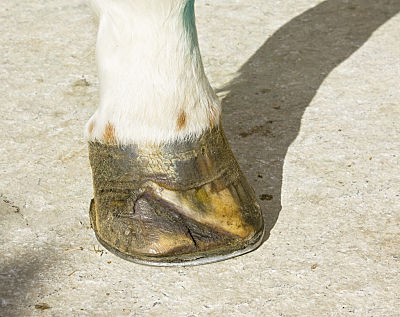 Here is a slightly newer image (January 1st), although I don't know if it adds anything. It may look as if the crack stops before reaching the descending wall, but that is only because the wall is really thick and chunky here. |
| Member: frances |
Posted on Thursday, Jan 7, 2010 - 10:48 am: Correction: I was wrong to use the words "continues upwards", as the crack has definitely been growing DOWN since it first appeared at the top of the resected area (see image in my July 21st post no 910).What I meant was that the crack IS VISIBLE from the bottom of the foot to where the hoof wall has grown down. Unfortunately, when I compare it today with the picture in my Oct. 25th post no. 972, it does kind of look as if it covers a larger area now, so whether or not it has recently enlarged I'm not sure. |
| Moderator: DrO |
Posted on Thursday, Jan 7, 2010 - 6:08 pm: Hmmmm it looks pretty clean and dry and did not form from an upward progressively infection, I think there is a good chance this will just grow out but this is just my best guess. Be vigilant for odor or goo.DrO |
| Member: frances |
Posted on Friday, Jan 8, 2010 - 12:33 am: So do you think the dental impression material and pad will trap debris if the distal area is rasped out to relieve pressure on the crack? |
| Moderator: DrO |
Posted on Friday, Jan 8, 2010 - 7:35 am: I don't know LL, it is a possibility. I would ask this question of the person applying the material. They will know a bit better the consistency and adhesive properties that might allow stuff to get under it. The defect could even be filled in if the dental impression material is soft enough not to put much pressure on it.DrO |
| Member: frances |
Posted on Saturday, Jan 9, 2010 - 7:09 am: Thank you very much for all your help. |
| Member: frances |
Posted on Tuesday, Feb 9, 2010 - 6:02 am: An update: rasping the area distal to the crack as per your advice DrO seemed to work very well. You can hardly see it any more in "real life", although in the picture it still appears visible (why do hooves always look worse in photos?).Another crack has opened up from the bottom on the left of the image as you look at it. The farrier said it was just an old nail hole, and opened it up more, presumably so I could keep it clean. I'm fascinated to see that an area of new hoof wall has grown in, also at the bottom left of the resected area. It's the lighter-colored area. Couldn't understand at first how it had got there since new wall grows down from the coronet (had it LEAPT across the upper resected area?!) until I reread your article DrO and was reminded that wall corium can build/thicken hoof wall too). This is a good thing, right? 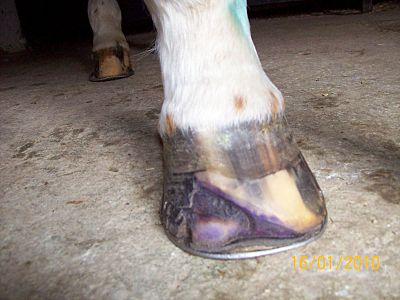
|
| Moderator: DrO |
Posted on Tuesday, Feb 9, 2010 - 7:12 am: Hello LL,Your description sounds very encouraging and nothing in the image suggests different. DrO |
| Member: frances |
Posted on Tuesday, Feb 9, 2010 - 2:33 pm: Thank you. |
| Member: frances |
Posted on Monday, Aug 16, 2010 - 8:07 am: Ta da! At last it's all grown out - took over a year. (The red at the front is just the effect ofa spot of copper sulphate on the toe clip.) 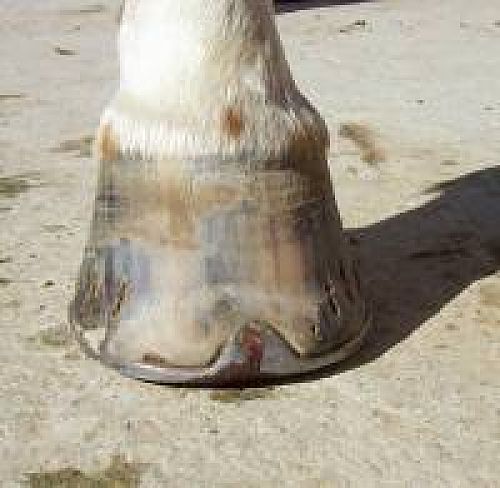
|
| Member: lilo |
Posted on Monday, Aug 16, 2010 - 11:23 am: Congratulations!! Lilo |
| Member: canter |
Posted on Monday, Aug 16, 2010 - 12:45 pm: That's great news, LL. Hopefully you can now take a deep sigh of relief?? |
| Member: vickiann |
Posted on Monday, Aug 16, 2010 - 9:15 pm: Great news, Lilo. |
| Member: scooter |
Posted on Monday, Aug 16, 2010 - 9:33 pm: Good to hear LL. Is she sound now? |
| Member: frances |
Posted on Tuesday, Aug 17, 2010 - 5:49 am: Thanks guys. Yes Fran the sigh of relief must have been heard even across the Atlantic!Diane, good question .... and the answer is ... YES! (Do hope I'm not jinxing things here - to be honest, I'm always slightly hesitant to post a good news update, just in case ... you know how it is.) She's sound for walk, trot, canter - haven't yet asked for any lateral work, but I probably could by now. There doesn't seem to be any residual problem at all from the hoof. The only glitch we had in coming back into work was an arthritic flare-up in her LEFT knee (WLD was in RF) when we started trotting after so long without having done anything other than walk. However that was resolved in a couple of weeks and she was later pronounced good to go at all paces! (I continue to cold hose the knee though after riding and apply Ice Tight if she's worked.) So yes, I'm a happy camper right now, and I hope this will encourage others whose horses may have to go through this too. |
| Member: scooter |
Posted on Tuesday, Aug 17, 2010 - 6:59 am: Great!... Thanks for the update and I do know about jinxing yourself with good news, but we must be brave sometimes Thanks for the update and I do know about jinxing yourself with good news, but we must be brave sometimes
|
| Member: frances |
Posted on Wednesday, Oct 20, 2010 - 9:25 am: Sooo ... after the last farrier visit, on Sept. 24th, I found that the RF toe area had had to be resectioned again - not a huge amount, about one or 1 1/2 inches in height. I can also see a tiny gap with a crack leading up from it in the LF toe (not resectioned).DrO, do you think that putting a toe clip on the newly grown back hoof wall (which the farrier did on his PREVIOUS visit - see photo in my August 16th post) might have contributed to the recurrence of WLD after only a 6 week respite? The farrier feels my horse must have a notch in the distal area of the coffin bone, something he's said before; I suppose what he really means is not so much the notch, which all horses have I believe, but a resulting hyperkeratinzed "blob" that we've discussed before on these boards(thanks for naming it Diane). Although I don't want to be unfair, I'm thinking of changing to another farrier, partly for a fresh pair of eyes, and partly because the current one never debrides sufficiently - he denies it, but there's always an overhang which I have to go to all kinds of contortions to reach with medication, and never can be sure I've really got to. |
| Member: scooter |
Posted on Wednesday, Oct 20, 2010 - 4:53 pm: Hi LL, I was able to get rid of Hanks blob by digging at it daily and putting thrushbuster in it. Personally I don't think a clip would be a good thing for one of these. Unloading the crack and keeping the blob dug out and treated worked rather quickly for Hank...It was deep just like a rotten part of an apple |
| Moderator: DrO |
Posted on Wednesday, Oct 20, 2010 - 6:29 pm: Hello LL,I don't think the clip would increase the chance of recurrence but I do agree incomplete removal of diseased horn would cause recurrence. DrO |
| Member: canter |
Posted on Thursday, Oct 21, 2010 - 6:59 am: Sorry for the setback, LL. Hopefully it is just minor and you are back on track very soon. |
| Member: frances |
Posted on Thursday, Oct 21, 2010 - 2:17 pm: Thanks a lot for the responses. I'm wondering whether it is a new infection, or whether the old one wasn't completely removed.There was a small amount of swelling on the outside of the pastern a couple of weeks ago (in the same place as the large swelling at the start of this thread), but I've been applying Ice Tight all around the pastern after work and it seems to have gone down. |
is The Horseman's Advisor
Helping Thousands of Equestrians, Farriers, and Veterinarians Every Day
All rights reserved, © 1997 -
